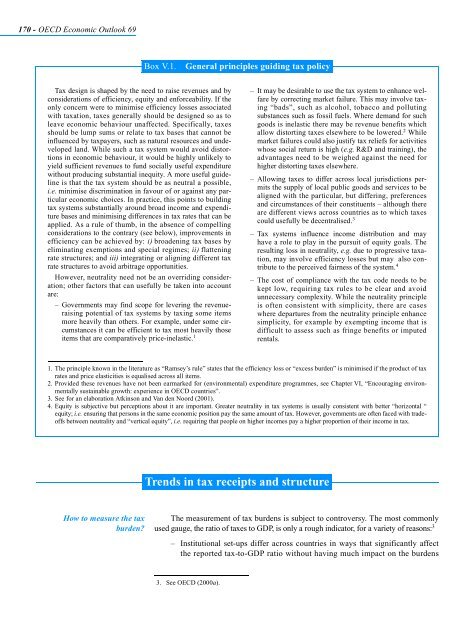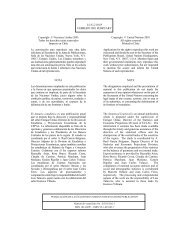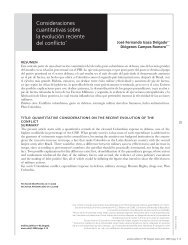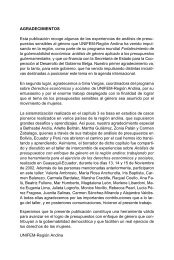OECD Economic Outlook 69 - Biblioteca Hegoa
OECD Economic Outlook 69 - Biblioteca Hegoa
OECD Economic Outlook 69 - Biblioteca Hegoa
Create successful ePaper yourself
Turn your PDF publications into a flip-book with our unique Google optimized e-Paper software.
170 - <strong>OECD</strong> <strong>Economic</strong> <strong>Outlook</strong> <strong>69</strong><br />
Tax design is shaped by the need to raise revenues and by<br />
considerations of efficiency, equity and enforceability. If the<br />
only concern were to minimise efficiency losses associated<br />
with taxation, taxes generally should be designed so as to<br />
leave economic behaviour unaffected. Specifically, taxes<br />
should be lump sums or relate to tax bases that cannot be<br />
influenced by taxpayers, such as natural resources and undeveloped<br />
land. While such a tax system would avoid distortions<br />
in economic behaviour, it would be highly unlikely to<br />
yield sufficient revenues to fund socially useful expenditure<br />
without producing substantial inequity. A more useful guideline<br />
is that the tax system should be as neutral a possible,<br />
i.e. minimise discrimination in favour of or against any particular<br />
economic choices. In practice, this points to building<br />
tax systems substantially around broad income and expenditure<br />
bases and minimising differences in tax rates that can be<br />
applied. As a rule of thumb, in the absence of compelling<br />
considerations to the contrary (see below), improvements in<br />
efficiency can be achieved by: i) broadening tax bases by<br />
eliminating exemptions and special regimes; ii) flattening<br />
rate structures; and iii) integrating or aligning different tax<br />
rate structures to avoid arbitrage opportunities.<br />
However, neutrality need not be an overriding consideration;<br />
other factors that can usefully be taken into account<br />
are:<br />
– Governments may find scope for levering the revenueraising<br />
potential of tax systems by taxing some items<br />
more heavily than others. For example, under some circumstances<br />
it can be efficient to tax most heavily those<br />
items that are comparatively price-inelastic. 1<br />
How to measure the tax<br />
burden?<br />
Box V.1. General principles guiding tax policy<br />
– It may be desirable to use the tax system to enhance welfare<br />
by correcting market failure. This may involve taxing<br />
“bads”, such as alcohol, tobacco and polluting<br />
substances such as fossil fuels. Where demand for such<br />
goods is inelastic there may be revenue benefits which<br />
allow distorting taxes elsewhere to be lowered. 2 While<br />
market failures could also justify tax reliefs for activities<br />
whose social return is high (e.g. R&D and training), the<br />
advantages need to be weighed against the need for<br />
higher distorting taxes elsewhere.<br />
– Allowing taxes to differ across local jurisdictions permits<br />
the supply of local public goods and services to be<br />
aligned with the particular, but differing, preferences<br />
and circumstances of their constituents – although there<br />
are different views across countries as to which taxes<br />
could usefully be decentralised. 3<br />
– Tax systems influence income distribution and may<br />
have a role to play in the pursuit of equity goals. The<br />
resulting loss in neutrality, e.g. due to progressive taxation,<br />
may involve efficiency losses but may also contribute<br />
to the perceived fairness of the system. 4<br />
– The cost of compliance with the tax code needs to be<br />
kept low, requiring tax rules to be clear and avoid<br />
unnecessary complexity. While the neutrality principle<br />
is often consistent with simplicity, there are cases<br />
where departures from the neutrality principle enhance<br />
simplicity, for example by exempting income that is<br />
difficult to assess such as fringe benefits or imputed<br />
rentals.<br />
1. The principle known in the literature as “Ramsey’s rule” states that the efficiency loss or “excess burden” is minimised if the product of tax<br />
rates and price elasticities is equalised across all items.<br />
2. Provided these revenues have not been earmarked for (environmental) expenditure programmes, see Chapter VI, “Encouraging environmentally<br />
sustainable growth: experience in <strong>OECD</strong> countries”.<br />
3. See for an elaboration Atkinson and Van den Noord (2001).<br />
4. Equity is subjective but perceptions about it are important. Greater neutrality in tax systems is usually consistent with better “horizontal “<br />
equity; i.e. ensuring that persons in the same economic position pay the same amount of tax. However, governments are often faced with tradeoffs<br />
between neutrality and “vertical equity”, i.e. requiring that people on higher incomes pay a higher proportion of their income in tax.<br />
Trends in tax receipts and structure<br />
The measurement of tax burdens is subject to controversy. The most commonly<br />
used gauge, the ratio of taxes to GDP, is only a rough indicator, for a variety of reasons: 3<br />
– Institutional set-ups differ across countries in ways that significantly affect<br />
the reported tax-to-GDP ratio without having much impact on the burdens<br />
3. See <strong>OECD</strong> (2000a).
















